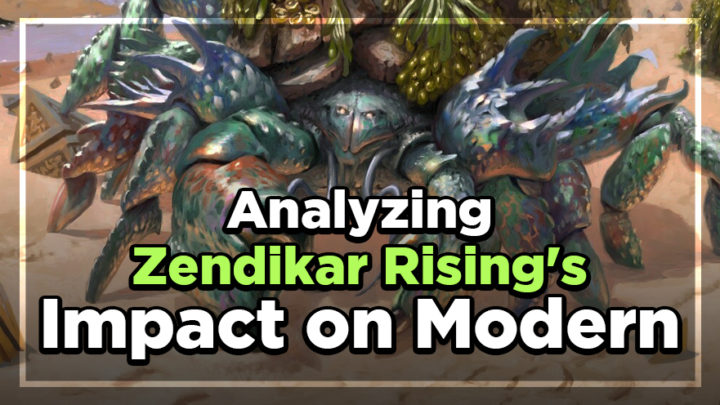Zendikar Rising has shown that it has a number of cards that are Modern-playable, and many of them are already bearing results. While I wrote about how premier decks such as Amulet Titan and Death’s Shadow were getting new toys, it was the dark horses of Modern that had the most to gain. Death and Taxes, Dimir Mill, and Belcher all put up solid results last weekend on MTGO. Was it something about the metagame that sparked these performances, or the new tools provided by Zendikar Rising?
Death and Taxes by Metcalf23, 2nd place MTGO Challenge

4 Flickerwisp
4 Giver of Runes
4 Leonin Arbiter
4 Stoneforge Mystic
4 Thalia, Guardian of Thraben
4 Path to Exile
4 Aether Vial
1 Batterskull
1 Sword of Fire and Ice
4 Field of Ruin
4 Ghost Quarter
1 Horizon Canopy
9 Plains
1 Scavenger Grounds
2 Shefet Dunes
1 Silent Clearing
1 Sunbaked Canyon
2 Archon of Emeria
4 Skyclave Apparition
1 Maul of the Skyclaves
SIDEBOARD
2 Aven Mindcensor
3 Burrenton Forge-Tender
1 Gideon, Ally of Zendikar
2 Phyrexian Revoker
3 Rest in Peace
2 Settle the Wreckage
2 Winds of Abandon
Modern Death and Taxes isn’t quite at the same power level as its Legacy counterpart despite playing many of the same or similar spells. The construction of the decks are nearly identical: cheap, disruptive white creatures powered by Aether Vial; a Stoneforge Mystic package; lands that disrupt the opponent’s mana. Mana disruption and Aether Vial are the backbone of any D&T deck.

The individual creatures are frankly underwhelming in combat, but Aether Vial lets you cheat on mana to simply commit more to the board than most opponents. Ghost Quarter and Field of Ruin when combined with Leonin Arbiter do a reasonable impression of Wasteland and Rishadan Port. Thalia, Heretic Cathar has shown up from time to time to help keep the opponent off balance just a little bit longer; now, Archon of Emeria fills that role while also preventing players from casting more than one spell each turn. Aether Vial and Stoneforge Mystic let Death and Taxes circumvent that restriction by effectively casting additional spells, without actually casting them.

The land denial strategy is so important because Death and Taxes doesn’t scale particularly well into longer games. Your creatures get outsized, and Thalia, Guardian of Thraben and Leonin Arbiter’s taxing effects get easier to pay. This means you need to keep your opponent from scaling by attacking their mana from multiple angles. That way, you can preserve the early game strength of your cards for long enough to close the game.

Skyclave Apparition is making the rounds, and making some noise along the way. Normally, creatures that exile creatures bring the exiled creature back when they die. Skyclave Apparition is significantly better than that, as it can exile any nonland, nontoken permanent with converted mana cost four or less (which functionally isn’t a restriction in Modern). Removal is significantly worse than it usually is against this effect, because instead of just giving the permanent back after Skyclave Apparition dies, they just get a token with power and toughness equal to the exiled card’s mana cost. I know that I’d personally much rather have a 3/3 token than their Uro, Titan of Nature’s Wrath! There is also some cool play between Aether Vial, Skyclave Apparition, and Flickerwisp — getting to exile permanents at instant speed is usually quite a difficult effect to come across, especially in white.

Maul of the Skyclaves also sneaks its way into the Stoneforge Mystic package. Due to the nature of the free equip you get when it enters the battlefield, you can save a ton of mana off the sticker price, especially when you put it into play on your opponent’s end step, or blow them out in combat with it!
Dimir Mill by TheEnzym, 1st place MTGO Challenge

2 Ashiok, Dream Render
4 Hedron Crab
4 Glimpse the Unthinkable
4 Archive Trap
1 Cling to Dust
4 Fatal Push
2 Surgical Extraction
4 Visions of Beyond
3 Mesmeric Orb
2 Fraying Sanity
3 Darkslick Shores
3 Field of Ruin
1 Flooded Strand
3 Island
1 Mikokoro, Center of the Sea
1 Oboro, Palace in the Clouds
4 Polluted Delta
2 Prismatic Vista
1 Swamp
3 Watery Grave
4 Ruin Crab
4 Bloodchief’s Thirst
SIDEBOARD
1 Crypt Incursion
1 Ensnaring Bridge
2 Force of Negation
2 Profane Memento
4 Ravenous Trap
2 Search for Azcanta
3 Stern Dismissal
Dimir Mill was on the edges of being a competitive Modern deck for some time now. I’ve always liked to think of Mill occupying a similar place to Burn, in the sense that Mill is always going to do the thing that Mill does and you have to beat them before they kill you, or bring specific hate. Turns out that the Mill cards were just a little slower than Burn, which meant that unless people were going out of their way to do a chunk the milling for you, it’s just better to play Burn.

Ruin Crab may seem unassuming — honestly, Hedron Crab is kind of unassuming — but it is quietly among the best cards in Mill. In fact, a third point of toughness is quite important to keep you alive against decks like Humans and Prowess. Getting a slightly better copy of your best card is like Burn getting a slightly better copy of Lightning Bolt, which is a much more obvious gain in the context of Modern. The fastest Mill kills often involve turn one Hedron Crab, and going from 40% of opening hands having a crab to 65% is a huge increase in your best draws.

While Maddening Cacophony didn’t make this specific version of the deck, it certainly could show up if Leyline of Sanctity becomes more popular. 80% of Glimpse the Unthinkable without needing to worry about Leyline is pretty strong when you also get to play it alongside Glimpse. While Breaking//Entering doesn’t see play in Mill currently, Maddening Cacophony is much easier on the mana. You have a relatively high density of black spells without a ton of black mana, so being able to cast Maddening Cacophony and Fatal Push in the same turn is significantly easier. Combine the mana cost with the benefit of skating by Leyline of Sanctity and Maddening Cacophony looks much better for Mill.
Belcher by SKK, Top 8 Modern Champs

4 Simian Spirit Guide
4 Irencrag Feat
4 Recross the Paths
1 Reforge the Soul
4 Desperate Ritual
4 Manamorphose
4 Pyretic Ritual
4 Chalice of the Void
4 Goblin Charbelcher
4 Blood Moon
3 Tangled Florahedron
4 Bala Ged Recovery
4 Shatterskull Smashing
4 Spikefield Hazard
4 Turntimber Symbiosis
4 Valakut Awakening
SIDEBOARD
1 Collected Company
3 Leyline of Sanctity
3 Lightning Bolt
1 Thassa’s Oracle
1 Undercity Informer
4 Veil of Summer
2 Wilt
Wow, the Legacy ports keep rolling in!
Belcher is well-known as the glass cannon deck of Legacy, but the Modern version never had quite the right tools to work. Land Grant and Elvish Spirit Guide provide the Legacy version with enough free mana that they can afford to only play a single land, making their miss rate as low as possible. The Modern version previously had to play some real stinkers, like Chancellor of the Tangle as a budget Elvish Spirit Guide on exactly turn one. Modern Belcher’s miss rate is entirely dependent on how many lands were left in your deck when you activate Goblin Charbelcher; the “normal” number of lands was seven, which left you with a real possibility of failing to go off.

Belcher has likely the highest percentage gain from double-faced lands. Instead of having to play a pile of sub-par cards that get lands out of your deck to try and drop your fail rate, you now just get to put lands in your deck. The ability to play lands is something that every other Magic deck takes for granted, and now Belcher gets to enjoy that luxury.
The real kicker, though: because the double-faced lands are only lands on the back, Goblin Charbelcher can never miss. It will always deal damage equal to the number of remaining cards in your library. Additionally, because all of the lands in the deck are also spells, it makes it incredibly difficult for Belcher to flood — especially when one of the double-faced cards is Valakut Awakening, which can churn through a ton of cards.
Nonetheless, Belcher still remains a glass cannon deck. Its only reliable win condition is Goblin Charbelcher, so it isn’t uncommon to see one on the stack on turn three.
Conclusion
Zendikar Rising has made a significant impact on Modern, and this was just the first week! Seeing underrepresented decks put up excellent results right away bodes well from things to come. I know that I’ll be keeping a close eye on the developments of Modern as things progress, and hopefully we’ll see more innovations in the coming weeks.
I’d love to know which Zendikar Rising card you think will be the next to become a Modern staple. Be sure to reach out to me on Twitter at @RappaciousOne to let me know! I’ll see you all next week here at Card Kingdom.

Michael Rapp is a Modern specialist who favors Thoughtseize decks. Magic sates his desire for competition and constant improvement.

